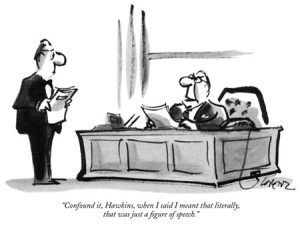 “Don’t be smart, Mister!” I scolded my then 8 year old Aspie son, after he back-talked me about something or other. He looked at me, wide-eyed with confused uneasiness. He knew from my tone of voice that I was angry with him, but he didn’t understand my words… (Don’t be smart? Isn’t being smart a good thing? What is wrong???)
“Don’t be smart, Mister!” I scolded my then 8 year old Aspie son, after he back-talked me about something or other. He looked at me, wide-eyed with confused uneasiness. He knew from my tone of voice that I was angry with him, but he didn’t understand my words… (Don’t be smart? Isn’t being smart a good thing? What is wrong???)
As I watched his facial expression retreat from disrespect to confusion to worry, I realized that we were experiencing a breakdown in communication. I stopped and considered my impulsive reprimand… Ah ha!!!- Gregory was interpreting my words literally! At face value, the idiomatic phrase “Don’t be smart” went contrary to my usual promptings, so naturally it didn’t make sense to him.
Like most Aspies, Gregory is naturally very literal and needs to be explicitly taught to recognize when an idiom or other figurative language is being used. Once I explained that “Don’t be smart” is a figure of speech that means ‘Don’t be fresh’ (hmmm…ok, that’s another figure of speech….) or ‘Don’t be disrespectful’, then he understood. My message got through and he apologized for being rude. My mission was accomplished with that particular communication ‘battle’, but I realized that we had yet to win the ‘war’…
The Hidden Curriculum – Part III – Figurative Language
As discussed in my blog series The Hidden Curriculum, Aspies and others with social-cognitive learning disabilities, can have great difficulty decoding hidden curriculum rules. Figurative speech, and most especially idioms, fall into this category.
 A life-long avid reader, I adore imaginative figurative language and admire writers who can incorporate it effectively into their writing to add color and interest. Well written prose, with the help of ingenious figures of speech, can take a rather mundane concept and turn it into a memorable, thought-provoking ‘pearl of wisdom’.
A life-long avid reader, I adore imaginative figurative language and admire writers who can incorporate it effectively into their writing to add color and interest. Well written prose, with the help of ingenious figures of speech, can take a rather mundane concept and turn it into a memorable, thought-provoking ‘pearl of wisdom’.
As you may recall from your grade school English classes, figurative language contains images and comparisons. The speaker describes something through the use of unusual comparisons, for effect, interest, and to make things clearer. Appealing to the imagination, figurative language provides new ways of looking at the world – adding richness and depth to our communication.
To refresh your memory, here are some common types of figurative language that we use on a daily basis: (See how well you remember… I had to look a few of these up!)
 As fun, creative and widely used as it is, figurative speech is not intended to be interpreted in a literal sense. And herein lays the problem…. It is common for young kids to take things too literally, but when this misunderstanding continues with age, it can create significant comprehension and therefore social issues.
As fun, creative and widely used as it is, figurative speech is not intended to be interpreted in a literal sense. And herein lays the problem…. It is common for young kids to take things too literally, but when this misunderstanding continues with age, it can create significant comprehension and therefore social issues.
Figures of Speech Game
To help Gregory develop his sense of figurative language, I created a “Figures of Speech” game that we played each night at dinner time. I printed out hundreds of common idioms, such as “Quit horsing around”, “Roll with the punches”, and “Bite my head off”. (An entire chapter is devoted to examples of Figurative Speech and Idioms in Brenda Myles’s wonderful book, The Hidden Curriculum, which formed the basis of my series on the subject.) As we all sat around the table, one of the kids would read aloud a figure of speech from a little slip of paper and then everyone would try to guess what it meant. Then I told them what it meant figuratively, including, whenever possible, how it originated. We giggled about how silly it sounded when interpreted literally, so they could begin to recognize these types of phrases in daily life.
During the game, we would review sayings that we had already covered, to reinforce the learning process. This time around, the kids usually guessed/expressed the figurative meaning correctly. We also had lots of fun having everyone come up with other idioms, either from things they had heard or from their imagination. We all enjoyed many laughs and the lessons got through, because nowadays, when Gregory hears an idiom on tv or reads one in a book, he’ll turn and inform me, “That’s a figure of speech!”
I am Tongue Tied
 During a school book fair where I was volunteering, I came across a wonderfully silly kid’s book called Even More Parts by Tedd Arnold (of Fly Guy fame.) Through the use of very cute cartoons, the author introduces all sorts of common idioms dealing with body parts – from head to toe! Just imagine the literal illustrations of someone saying “I lost my head”, “I keep changing my mind” or “I am tongue tied” – hysterical! I bought it immediately – what a fun way to ‘get’ figurative language! I presented it to Gregory, who was instantly mesmerized by the cartoon pictures of a man who ‘sang his heart out’ (his red, beating heart falling onto the floor), and the boy who ‘went to pieces’ (his snap-together body parts strewn all along the sidewalk). The book was a huge hit with all three of the kids, who giggled at the absurdity of the literal interpretations to these well known idioms, so I subsequently bought the complete set (Parts and More Parts!) Kudos Mr. Arnold!
During a school book fair where I was volunteering, I came across a wonderfully silly kid’s book called Even More Parts by Tedd Arnold (of Fly Guy fame.) Through the use of very cute cartoons, the author introduces all sorts of common idioms dealing with body parts – from head to toe! Just imagine the literal illustrations of someone saying “I lost my head”, “I keep changing my mind” or “I am tongue tied” – hysterical! I bought it immediately – what a fun way to ‘get’ figurative language! I presented it to Gregory, who was instantly mesmerized by the cartoon pictures of a man who ‘sang his heart out’ (his red, beating heart falling onto the floor), and the boy who ‘went to pieces’ (his snap-together body parts strewn all along the sidewalk). The book was a huge hit with all three of the kids, who giggled at the absurdity of the literal interpretations to these well known idioms, so I subsequently bought the complete set (Parts and More Parts!) Kudos Mr. Arnold!
* * * * * * *
Today, as a result of our ‘Figures of Speech’ game, the Parts books and lots of general reading, Gregory has a well-developed sense of figurative language. Even when he doesn’t understand exactly what an idiom means, he recognizes that the phase is not meant literally. But even better yet, Gregory uses figures of speech himself – to add richness and creativity to his own speech and writing!
So, the next time your child becomes concerned for your safety because you are “just going to jump in the shower….”, you might want to consider a couple of these techniques too. Comprehending idioms and figurative speech can pose real difficulties for those on the Spectrum who see the world through literal ‘glasses’, but with a little work and a lot of silliness, our kids don’t have to stay ‘out in left field’…
Related Articles
- The Hidden Curriculum (asdhelp.wordpress.com)
- How Rude! (asdhelp.wordpress.com)



